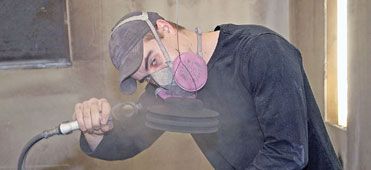
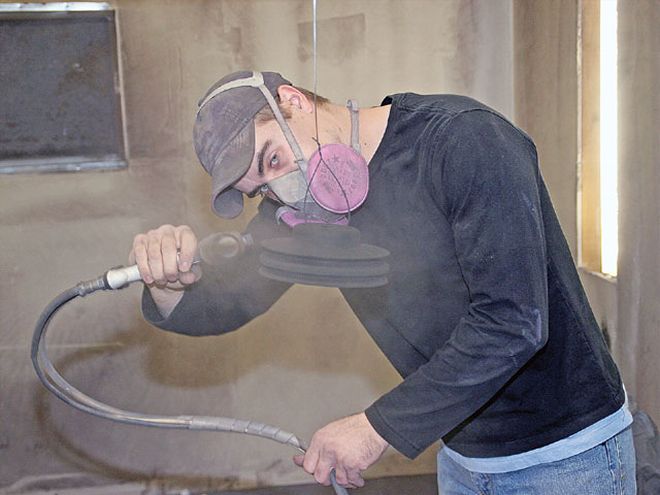
Most hobbyists are familiar with the process of repainting a vehicle's exterior. In last month's issue of HPP, we heard a professional's opinion about the current trends and effects that modern technology has had on overall finish durability and the industry in general.
Best suited for components that are subjected to increased levels of heat or abuse, powdercoat is a highly durable product that's rapidly gaining in popularity within the automotive hobby. However, many hobbyists aren't acquainted with the colors presently available, the application process, or the benefits a powdercoated finish offers, so we contacted Josh Trail of Trail Performance Coating in Omaha, Nebraska, seeking a professional opinion. Here's what he has to say.
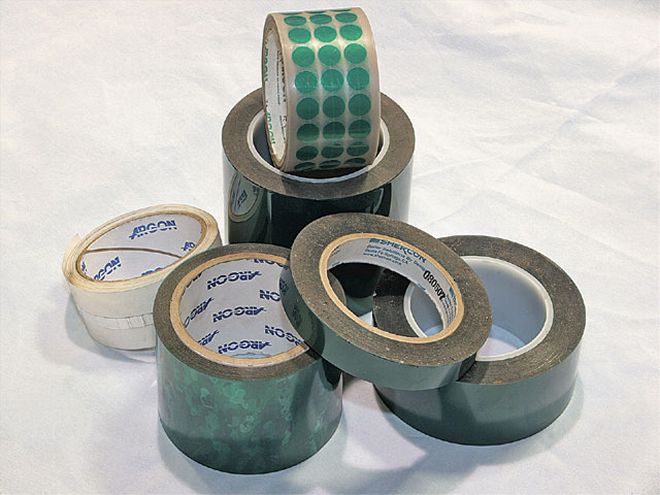 The intense heat associated with powdercoating requires masking materials that are specifically designed for that task.
The intense heat associated with powdercoating requires masking materials that are specifically designed for that task.
High Performance Pontiac: What do you feel has sparked the powdercoat popularity boom within the automotive hobby?
Josh Trail: When compared to conventional painting, powdercoating is generally cheaper and the finish doesn't shrink or check. It's also much more durable than paint. That's because the "powder," which is actually finely ground plastic, totally encases the component when melted and cured, resulting in a tough finish that's scratch and chip resistant. Unlike paint, which tends to harden as its solvent base dissipates, cured powder remains somewhat flexible, making it desirable in a wide range of applications.
Manufacturing companies and the aerospace industry have used powdercoat for quite some time, and its use has trickled into home life. We've powdercoated patio furniture, lawn and garden equipment, and even artwork for customers, but the majority of our jobs are automotive and motorcycle components. I believe much of that is due to its exposure in hobby-related television shows.
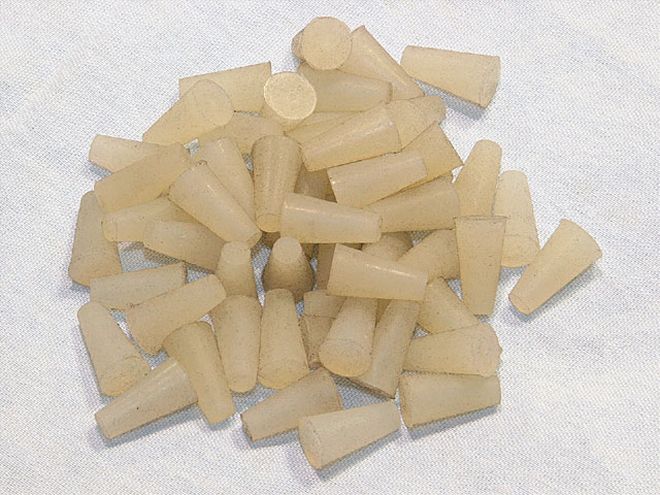
We're commonly coating suspension and underhood pieces in varying shades of black or cast-iron gray for local restoration shops, but we do many custom pieces, too. We're also coating lots of wheels-both steel and aluminum. We don't often receive requests to powdercoat body panels, however. Not only would panel preparation include metalwork without plastic fillers, the intense heat associated with the curing process might warp the metal.
HPP: Can you elaborate on the preparation, application, and clean-up processes?
JT: Powdercoating requires some specialized equipment. Compressed air is used to fluidize the powder, and air quality must be very high-it simply cannot contain any moisture. Like paint guns, the quality of a powdercoat gun is relative to its price, so you often get what you pay for. An open-ended paint booth with good lighting and positive ventilation is also required.
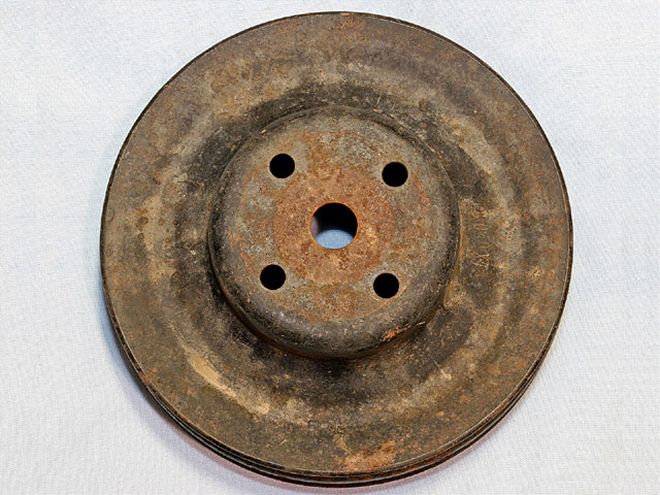 Powdercoating has become quite popular within the past few years. Trail Performance Coatings in Omaha, Nebraska, reports that suspension and underhood components are among the most common automotive components it coats for customers.
Powdercoating has become quite popular within the past few years. Trail Performance Coatings in Omaha, Nebraska, reports that suspension and underhood components are among the most common automotive components it coats for customers.
Any metal that can withstand a temperature of about 400 degrees F can be powdercoated, and surface preparation is a key element in the quality of the final finish. Some like using a chemical wash to clean the metal's surface, but I prefer mediablasting to promote maximum mechanical adhesion. If the powder doesn't adhere to the component well, it can lift, trapping moisture underneath, ultimately causing rust or corrosion to form.
After preparation, we hang the component in the paint booth and spray on a thorough coating of dry powder that's electrostatically charged. The piece is then baked at a temperature around 400 degrees F, which causes the powder to liquify and flow out uniformly.
Bake time varies on the type and thickness of the metal being coated-a 1/8-inch thick piece of aluminum may require 12 to 15 minutes, where a heavy cast-iron intake manifold may take 45 minutes to an hour to fully cure. There's some variance, but if the temp and time limits are grossly exceeded, gloss colors can dull while lighter hues can discolor. Under-cured powder is less adhesive and the overall finish is usually less durable.
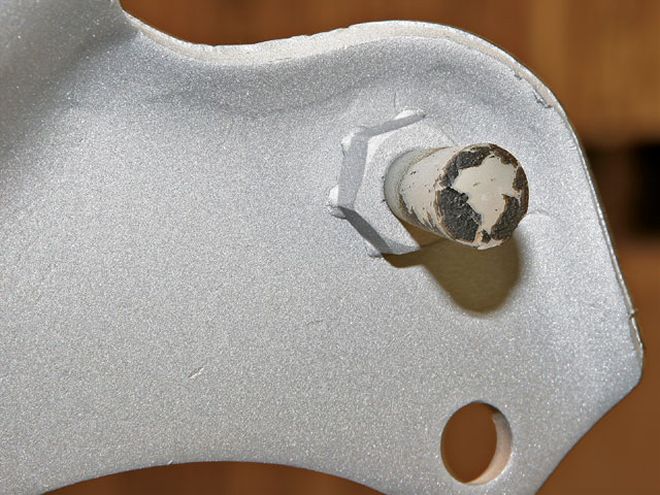 No masking was required, but this threaded hole on the bracket was plugged to prevent powder from coating the threads. The freshly blasted parts were then hung in the paint booth and negatively charged.
No masking was required, but this threaded hole on the bracket was plugged to prevent powder from coating the threads. The freshly blasted parts were then hung in the paint booth and negatively charged.
Once removed from the oven, the finish remains tacky for a few minutes, so we're careful not to touch it or kick up any dust that could settle onto it. As soon as the finish is cool to the touch, the component is ready for service. Clean up and disposal is pretty easy since powders contain no VOC (Volatile Organic Compound) pollutants. The overspray that falls onto the floor is swept up and baked in the oven until solid, then tossed into the trash after it's cured.
HPP: What is the purpose of electro-statically charging the powder?
JT: The electrostatic charge is designed to maximize coverage and adhesion, while preventing runs and minimizing waste. The powder is positively charged as it exits the gun and it's attracted to the component, which is grounded. The charge then dissipates once the piece reaches around 200 degrees in the oven.
HPP: Can you elaborate on the types and colors of powder typically used today?
JT: There are three types we commonly use. Polyester-based powder is the least expensive, while offering excellent durability; it's the choice of most powdercoat shops and home hobbyists. Epoxy-based powder is chemical resistant and offers the highest hardness, yet it's most flexible. Urethane-based powder is typically associated with specialty finishes like a candy coat or a transparent metallic.
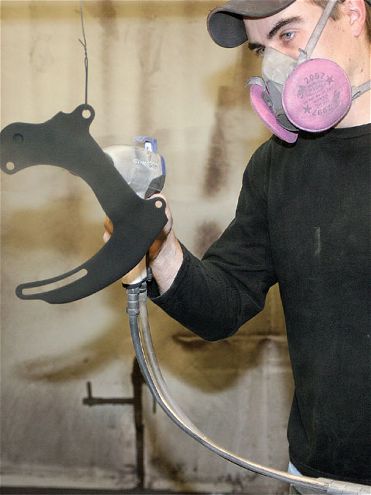 Using a product designed to replicate the color originally applied by Pontiac, Trail sprayed our pieces with black powder.
Using a product designed to replicate the color originally applied by Pontiac, Trail sprayed our pieces with black powder.
Color availability of powder is similar to paint. There's a wide array of flat, semi-flat, and gloss colors available from the manufacturers, and we try to steer customers in that direction. While we can add a limited amount of pearl or metallic to any powder to customize its color for a customer at additional charge, manufacturers can produce virtually any custom color imaginable, but it can be very costly for the customer.
Primer and clear powders are also options, but either can create a build-up of material, which might lessen the definition of a component's small details. Primer can leave a slightly smoother finish, while clear is used to increase depth and overall luster of the finish. Clear is mostly used when attempting to preserve a natural or polished aluminum finish like that of an intake manifold or aluminum wheel.
HPP: Must metal be preheated prior to applying powdercoat?
JT: Only dense, porous metals must be preheated, and that's to prevent "out gassing"-a condition similar to "solvent pop" when using paint. It occurs when the pores of low quality metal open as it warms, releasing gases originally trapped during the casting process. The gases then cause the finish to bubble, which can be difficult to repair.
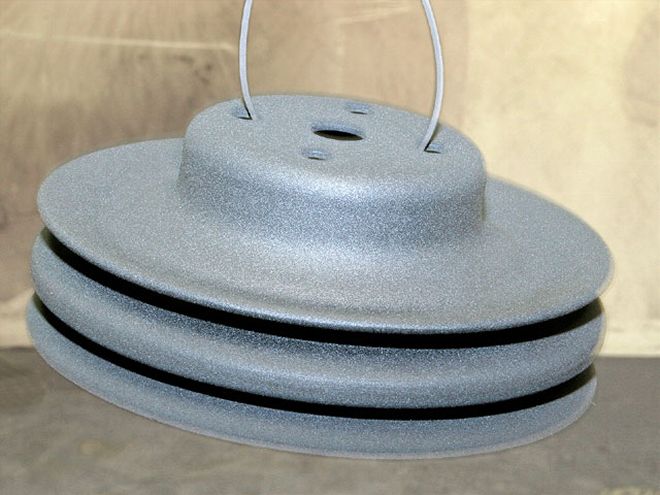 By applying an electrostatic charge to the powder as it exits the gun, it is uniformly distributed on to the grounded component.
By applying an electrostatic charge to the powder as it exits the gun, it is uniformly distributed on to the grounded component.
To combat out gassing, we first preheat the piece to our target temperature and apply the powder immediately after removing it from the oven. The powder actually begins to flow out as soon as it hits the hot metal, and then we place it back into the oven to completely finish the curing process.
HPP: Can rusty components be powdercoated?
JT: Yes, surface rust rarely leaves behind any surface roughness, but a pitted texture is often left after mediablasting a heavily rusted piece, which can be seen in the final finish. High-temperature metal fillers can be used to smooth a metal's surface before powdercoating, but metalwork that includes welding or brazing are options, too.
HPP: How can you prevent coverage on areas not intended to be powdercoated?
JT: We use a special heat-resistant tape to mask off such areas as a wheel's machined lip and place rubber plugs into areas such as bolt holes. If powder does get into an area it wasn't supposed to, we can chase threads with a tap while slots can be sanded or drilled out. Like any job, however, time is money, so if we have to spend a lot of time masking areas or plugging holes, the final cost can reflect that.
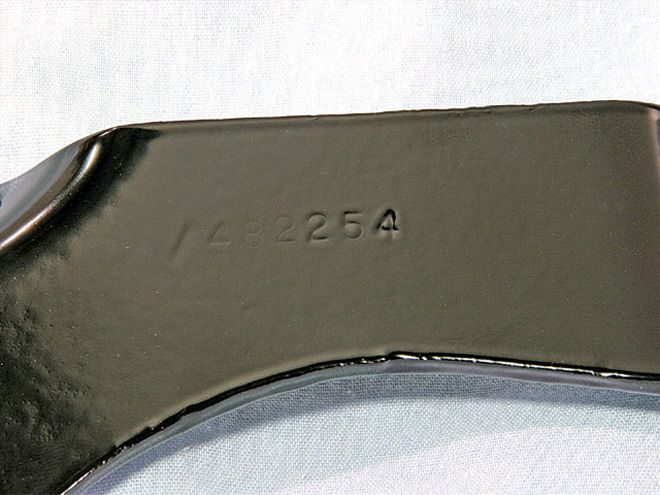 According to Trail, the average thickness of a single coat of powder is typically 2 to 3 mils. The part number on our particular alternator bracket was weakly stamped, but it's still clearly visible after a single application. Adding primer or clear will add to overall finish thickness and can lessen the definition of small details.
According to Trail, the average thickness of a single coat of powder is typically 2 to 3 mils. The part number on our particular alternator bracket was weakly stamped, but it's still clearly visible after a single application. Adding primer or clear will add to overall finish thickness and can lessen the definition of small details.
HPP: Can a powdercoated finish be smoothed like a conventional finish, and how does it age?
JT: A certain amount of orange peel is inherent in a powdercoated finish, but much like conventional paint, it can be wet-sanded and buffed to remove roughness or a run. Also like paint, a powdercoated finish can fade over time if neglected, but that can be prevented with routine exterior finish maintenance, which typically includes the same polishing you'd perform on paint. If fading does occur, a cleaner wax is usually all that's required to restore a finish's original luster.
HPP: How can you repair a powdercoated finish?
JT: Repairs are tough. Light scratches can be wet-sanded and buffed, while some moderate scratches can be heated with a heat-gun and reflowed. Deep scratches, dents, or chips are difficult to repair, and the process usually involves removing the existing finish. Cured powder can sometimes be blasted off or removed with a high-strength chemical stripper. It can also be burned off, but that requires a temperature of about 650 degrees F. Once it's stripped to bare metal and the necessary repairs made, the piece can be recoated from start to finish.
HPP: Can you powdercoat exhaust components?
JT: There are high-temperature powders on the market designed for coating an exhaust system, but I haven't been overly impressed with them. It seems the product just isn't durable enough to take extreme heat, like ceramic. I feel that if you're going to coat exhaust, ceramic is the best choice.
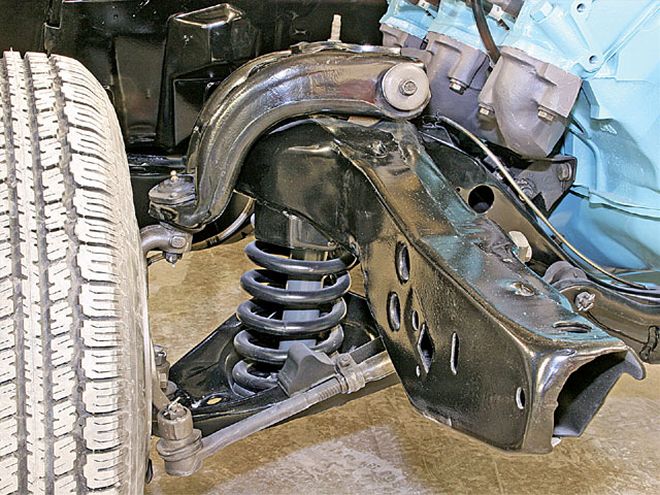 American Muscle Authority in Omaha, Nebraska, commonly uses Trail Performance Coating when restoring vehicles not destined for concours-type competition. Most of the suspension and underhood components of this '65 GTO were powdercoated during its restoration.
American Muscle Authority in Omaha, Nebraska, commonly uses Trail Performance Coating when restoring vehicles not destined for concours-type competition. Most of the suspension and underhood components of this '65 GTO were powdercoated during its restoration.
HPP: Can you provide some general comments about home-use kits available to hobbyists?
JT: Most commercially available powdercoat kits are suitable for the home hobbyist and will yield good results, but quality is relative to price. I've had good success with kits from Eastwood (www.eastwood.com) in the past, but one must keep in mind that they're not professional-grade, so the results can vary greatly with technique.
I strongly suggest that hobbyists practice on a spare piece before attempting to coat a valuable component, and that the correct tape and/or plugs be used for masking. I'd also suggest not using the oven in your kitchen when curing powder at home because each powder has its own distinct odor, and all the family members in your household might not welcome that!
Conclusion
After learning more from Trail about the powdercoating process and the quality finish that results, it comes as no surprise that powdercoating is a popular choice amongst hobbyists and professionals alike. With the wide range of colors available, it's likely that we'll see a greater number of components powdercoated in the future.
About Trail Performance Coating
Twenty-eight-year-old Josh Trail grew up an avid automotive and motorcycle enthusiast, so it's no surprise that he started a business specializing in that field. Trail began his career ceramic-coating exhaust components and learned the technique of powdercoating in his spare time using an Eastwood kit. In 2003, he established Trail Performance Coatings in Omaha, Nebraska, intending to specialize in ceramic coating and use powdercoating as a subsidy.
Trail reports that powdercoating presently represents over half his business. To accomodate that, he moved his operation into a new 4,000-square-foot facility within the past year, adding a plethora of updated equipment at the same time. Trail Performance Coating currently employs two full-timers, and a few part-timers to accommodate its present workload.